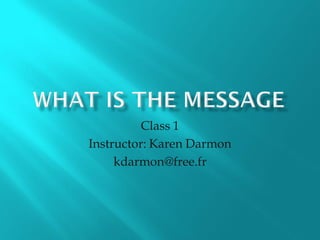Class monday feb7 the message
- 1. Class 1 Instructor: Karen Darmon kdarmon@free.fr
- 3. ’é© 1. Review of HW and Class Structure ’é© 2.To Identify ŌĆĢthe MessageŌĆ¢ ’éĪ What Do We Mean? ’éĪ How Do You Identify It? ’éĪ Characteristics And Criteria? ’éĪ Testing The WatersŌĆō Your 6 Word Sentences ’é© 3. To Apply It To The Blog ’éĪ What Will The Core Theme Of The Blog Be? ’éĪ What Are The Criteria For The Articles Posted? ’éĪ Content- Length; Pictures; Links;
- 4. ’é© Opening- Blog updates ’éĪ Blogmasters present their work/updates/ŌĆ¢issuesŌĆ¢ ’éĪ Editors give a one minute review of their article ’ā║ The goal is to get people to click on their article after the class. ’ā║ First classŌĆō 6 word stories ’éĪ Class lecture ’éĪ Exercise ’éĪ Eventually class presentations
- 5. ’é© The Blog- Maxence, Solene and Mathilde to discuss ’é© Also, am I ŌĆĢcatching an attitude?ŌĆöWhat is the purpose of the blog?
- 6. ’é© Communication is not what is SAIDŌĆ”ŌĆ”
- 8. And the ŌĆĢmissionŌĆ¢ is ’é© ENGINEERING THE LINK
- 10. BE SIMPLE!
- 12. ’é© A successful defense lawyer says, ŌĆĢ If you argue 10 points, even if each is a good point, when they get back to the jury room they wonŌĆÖt remember anythingŌĆ¢
- 13. The Secret Of Advertising Strategy: Have One Unique Selling Point That Positions You In A Clear, Identifiable Niche The Same Holds True In Communication- Every Piece Should Have Core Message
- 14. WHAT IS THE SINGLE ONE IDEA THAT YOU WANT SOMEONE TO TAKE AWAY? STRIP AN IDEA DOWN TO ITS SINGLE MOST CRITICAL ELEMENT- IN A WORD, OR 6
- 15. ’é© Rudyard Kipling, from "The Elephant's Child" in Just So Stories ’é© I keep six honest serving-men (They taught me all I knew); Their names are What and Why and When And How and Where and Who.
- 16. Karen Darmon kdarmon@free.fr Who Is the audience WHAT What do I need to say and, Why- How: My objective What medium should I use? Karen Darmon kdarmon@free.fr
- 17. ’é© A nalsysis--Who is the audienceŌĆō is it varied; the same people ’é© U nderstanding--What is it they know? What is it they need to know? ’é© D emographics--What is their age, gender, education, social background, ethnic background, etc. ’é© I nterest--Why is the audience there? What are they looking/listening for? ’é© E nvironment--What can distract the audience? Where will I stand? Can they see and hear me? ’é© N eeds--What does the audience need? What are my needs? ’é© C ustomized--What specific need(s) should I address? ’é© E xpectations--What should I expect to accomplish? What do they expect from me?
- 18. WHAT IS MY OBJECTIVEŌĆöWHY AM I TRYING TO: ŌĆó GENERATE INTEREST, ŌĆó CREATE A FOLLOWING, ŌĆó SHOW MY KNOWLEDGE AND IMPRESS OTHERS, ŌĆó GET A GOOD GRADE?
- 19. What do I need to say in order to be heard by the audience, and most importantly, how?
- 20. ’é©WHAT IS THE ONE TAKE AWAY POINT THAT YOU WANT THE AUDIENCE TO GET COULD BE - AN IMPRESSION - AN IDEA
- 21. 1. Identify what you want to sayŌĆō the core message 2. Determine the best way to communicate it.
- 22. THINKING FEELING BEHAVIOR Cognitive Affective Pre-existing Logic; Stimulates behavior to considers Emotion act in a pre-existing certain way knowledge and beliefs
- 24. ’é© From a magical place: the earth
- 25. From a magical place: the earth
- 26. ’é© Challenge; Inform; Conversation ’é© Blogs often include feedback comments by which readers can challenge or enhance the information provided. It also enables conversation which further enriches understanding. This interaction easily becomes conversation out of which further meaning is developed.
- 27. Karen Darmon kdarmon@free.fr Who do we want the audience to be? WHAT The CORE idea Why- To express_________? WHAT IS THE ONE THING I WANT TO SAY Karen Darmon kdarmon@free.fr
- 28. ’é© Should assignments include images? Links? ’é© Scheduling of deadlines ’é© Getting reach/coverage/readers ’é© DiscussionsŌĆöthe look?
- 29. ’é© For a message to be retransmitted to others, it must first be trusted ’é© Reliability -gives reliably sound information will be trusted more. ’é© Semantic similarity i-similarity of meaning and consequent similarity in personality.





























